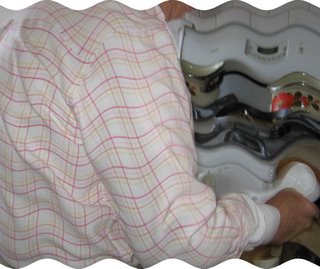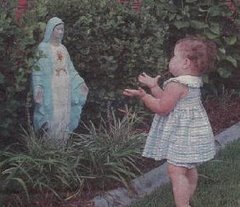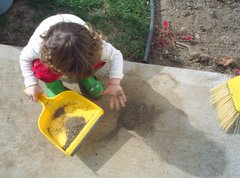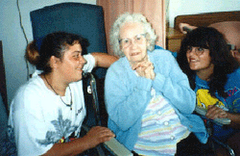The years 1972-1976 were undoubtedly the period of greatest religious turmoil in the Catholic Church in recent history. I can't think of a post-Vatican II time period other than the early- to mid-70's that generated more problems and losses for the Catholic church in the U.S.
In an interview with TIME magazine, Sarah Palin commented on dinner discussions with her parents, Chuck and Sally Heath, who had moved to Skagway Alaska in 1964:
...my dad was an elementary school teacher [science], so often our dinner-table conversations were about current events and about those things that an elementary school teacher teaches students — much about government and much about our nation...It is almost certain that these dinner-table conversations in the 1970s occasionally would have discussed religion, and likely critiqued the goings-on in the Catholic Church of that time. Sarah's family believes in many traditional Christian beliefs, and Sarah Palin, in many ways, acts and lives as though she were still an active Catholic.
So what was the problem? Why did Chuck and Sally Heath decide to leave the Catholic Church? According to a biography written by Kaylene Johnson, Sarah and her three siblings were each baptized into the Roman Catholic Church as infants. Consequently, during the period when all four children were born (approximately 1962 - 1966), the Heath family remained active Catholics.

What changed between 1966 (when Molly Heath their youngest child was born and baptized in the Catholic Church) and 1976 when Sarah Heath was "re-baptized" in Beaver Lake by the Assemblies of God minister?
According to the Johnson biography, the Heath family moved to Anchorage in 1969 (when Sarah was five years old) and lived for a short time with friends. They then moved to Eagle River (10 mi NE of Anchorage) before finally establishing a home in Wasilla further to the north. The move to Wasilla would have occurred before 1976 when Sarah and her family are known to have become members of the Wasilla Assemblies of God church.
So what was going on in the Catholic churches in Skagway (1964-1969), Anchorage (1969), Eagle River (1969 - ?), and Wasilla (before 1976)--during the period immediately before and during the time when the Heath family fell away from the Catholic church?
SKAGWAY: From 1964 to 1969, the Heath family lived in Skagway, Alaska, where Chuck Heath was a teacher and coach. The Skagway News shares information about Sarah Heath Palin's family while they lived in Skagway. An interesting quote shows that in 1969, when Sarah was 5, she was attending "catechism class," presumably at the very small St. Therese of the Child Jesus parish in Skagway.
“I was the same age when we left here [Skagway] as my daughter Piper is now,” she said. “I enjoyed watching her, seeing how things were through her eyes.” Palin said she used to walk “by myself – I don’t know if parents do that now –around town to the neighbors,” home from catechism [my emphasis], and remembered the wind blowing, drying the clothes in the back yard. Also going to her dad’s basketball games – he coached the [Skagway] high school team.Sarah Palin would have been a five year old catechism student in 1969. Thus, the Heath family remained practicing Catholics while they lived in Skagway. It is clear that only after the Heath's left Skagway in 1969 did they stop practicing their Catholic faith. Although other things in the Skagway Catholic community may have loosened the Heath's grip on their Catholic faith.
A relatively recent photo from the Skagway News in 2001 identifies Assembly of God Pastor Steve Smith preaching to those assembled for the Easter sunrise service at Pullen Park. The caption notes the Presbyterian Church and St. Terese Catholic Church joined with the Assembly of God to celebrate Easter, 2001. My comment: Perhaps this interdenominational scene may have played out much earlier in Skagway under the observation of the Heath family.
In 2002 the Diocese of Juneau (in which Skagway is located) had only 5,500 Catholics of a total 74,000 population, with 13 priests to serve the people. The first bishop appointed to serve the Juneau diocese, Robert Dermot O'Flanagan, was born in 1901 in Ireland and served as Bishop of Juneau from 1951 until his resignation on June 19, 1968. The history of the Juneau diocese notes that between 1968 and 1971, the Juneau diocese was remotely administered by the new Archbishop of Anchorage, Joseph T. Ryan. [Francis Thomas Hurley was not appointed to head the Juneau diocese until July 1971, two years after the Heath family had left Skagway.]
So would Bishop O'Flanagan have attracted or repelled the Heath family from 1964 to June 1968 when he resigned as Bishop? A historical vignette shows Bishop O'Flanagan as a down-to-earth individual who much resembled the hardworking Heath's:
During his early years he could be seen shoveling snow off the walks in the winter and in the summer cleaning up trash in the yard. He wore a pair of coveralls when he was doing his work stoking a wood burning furnace in the cellar of the church and raking up the yard. The ladies of the parish were worried about him not getting enough to eat or eating the right food.The Heath family stayed in Skagway for approximately a year after Bishop O'Flanagan's retirement in June 1968. No scandals are documented as happening in the Catholic church of Skagway while the Heath family resided there, but 1967-1969 was the time when massive changes began to be instituted in virtually all the Catholic churches in the world. The only other observation is that the small Skagway church may have had no resident pastor during this time, because in 1991 the parish was said to be served by visiting priests.
ANCHORAGE/EAGLE RIVER/WASILLA: The Heath family lived in Anchorage for only a short time at their friend's house, so it appears likely they left the Catholic Church while living in Eagle River and Wasilla (although earlier damage to their faith may have occurred while they lived in Skagway). Did the Heath family encounter something scandalous or destructive of faith in the Anchorage diocese when they moved there in 1969, especially after they moved to Eagle River and then to the Wasilla?
I wonder if part of the answer might be Fr. (Msgr) Frank Murphy who worked in parishes around Anchorage from 1960 to 1985. In 2004 a high school principal in Eagle River publicly accused the priest of a sexually abusive incident committed in 1982. Pat Podvin had exposed the priest in a dramatic television interview, and then committed suicide in 2005. Four other men also have said Murphy abused them as youngsters, including Podvin's older brother Kent. Here is an excerpt of the sad article from the Anchorage Daily News :
On Feb. 6, 2003, Podvin appeared in a televised interview with Channel 2's Maria Downey and declared he had been sexually abused as an 18-year-old by Monsignor Frank Murphy, a priest who worked in parishes around Anchorage from 1960 to 1985. Podvin said he was going public because the Anchorage Archdiocese had failed to acknowledge that any local priest had sexually abused youngsters here, and he was also critical of retired Archbishop Francis Hurley, to whom he complained about Murphy in 1982 but who never personally responded afterward until after he went public.The appalling story of Fr. Murphy's sexual assaults of young boys in the Anchorage Archdiocese over many years is told in gross detail in another article from the Anchorage Daily News. One wonders if Sarah Heath's older brother, who would have been ten years old in 1972, encountered this abusive priest.
For myself, I likely would not have stayed active in any Anchorage Catholic church if I had had to live under Archbishop Francis T. Hurley who began his rule in Juneau in 1971 and then was appointed to Anchorage in 1976. The Woodstock Theological Center identifies Francis T. Hurley of the Anchorage Archdiocese as one of the 15 Archbishops recommended to the Pope for appointment by the infamous Jean Jadot, the Vatican's apostolic delegate to the U.S in the 1970s:
Under Jadot, 15 archbishops were appointed: William D. Borders to Baltimore, Patrick F. Flores to San Antonio, Peter L. Gerety to Newark, James A. Hickey to Washington, Raymond G. Hunthausen to Seattle, Francis T. Hurley to Anchorage, Oscar H. Lipscomb to Mobile, Edward A. McCarthy to Miami, John L. May to St. Louis, Edward T. O'Meara to Indianapolis, John R. Quinn to San Francisco, John R. Roach to St. Paul, Charles A. Salatka to Oklahoma City, Robert Sanchez to Santa Fe, and Rembert G. Weakland to Milwaukee.Traditional Catholics recognize many of the above archbishops as clear enemies of the Catholic Church. The actions of these archbishops resulted in massive defections from the Catholic church in the 1970s and 1980s--both of priests and people. Fortunately, these archbishops have been replaced and the Catholic church is beginning to grow again in spirituality and numbers.
So what did the Heath's do with regard to their religious practices in the mid to late 1970's? The Johnson biography states: "With or without her husband, Sally bundled up the kids and took them to church every Sunday for morning and evening services and most Wednesdays too." Of course, that reference was to the Assemblies of God church--not a Catholic church.
Obviously, only the Heath family can answer the question of why they abandoned the Catholic church in the 1970s. I hope they identify their reasons as they understood them at the time they joined the Assemblies of God church in Wasilla.
**Photograph of little Sarah Heath is reprinted with express permission from the biography by Kaylene Johnson published by Epicenter Press of Alaska-- SARAH: How a Hockey Mom Turned Alaska's Political Establishment Upside Down. This photograph is copyright 2008 by Chris and Sally Heath who reserve all rights; please don't republish photograph elsewhere on the internet without obtaining their express permission in advance.











